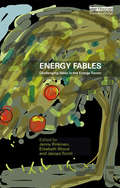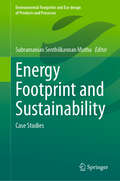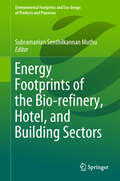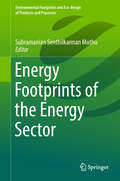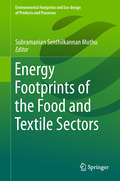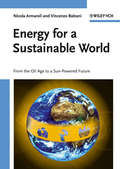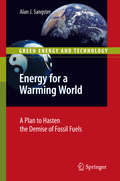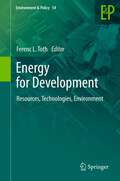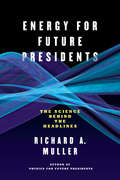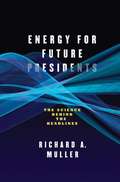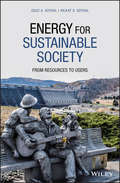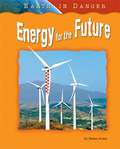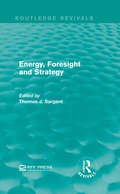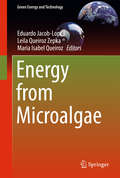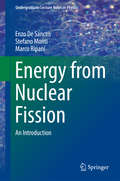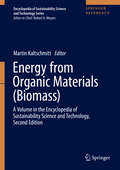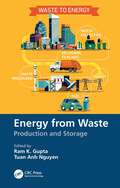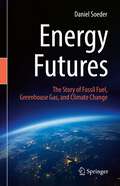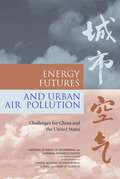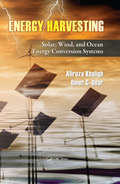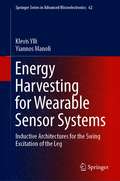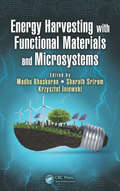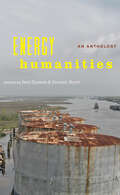- Table View
- List View
Energy Fables: Challenging Ideas in the Energy Sector
by Jenny Rinkinen Elizabeth Shove Jacopo TorritiEnergy Fables: Challenging Ideas in the Energy Sector takes a fresh look at key terms and concepts around which energy research and policy are organised. Drawing on recent research in energy and transport studies, and combining this with concepts from sociology, economics, social theory and technology studies, the chapters in this collection review and challenge different aspects of received wisdom. Brief but critical introductions to classic notions like those of ‘energy efficiency’, ‘elasticity’, ‘energy services’ and the ‘energy trilemma’, together with discussions and analyses of well-worn phrases about ‘low hanging fruit’ and ‘keeping the lights on’, articulate aspects of the energy debate that are often taken for granted. In re-working these established themes and adding twists to familiar tales, the authors develop a repertoire of new ideas about the fundamentals of energy demand and carbon reduction. This book presents a valuable and thought-provoking resource for students, researchers and policy-makers interested in energy demand, politics and policy.
Energy Footprint and Sustainability: Case Studies (Environmental Footprints and Eco-design of Products and Processes)
by Subramanian Senthilkannan MuthuThis volume orients readers to the concept of energy footprints and their implications for sustainability and offers several cases that illustrate this concept. Significantly, a detailed review chapter presents a of models and methods for measurement of energy footprints across different industrial sectors. Following this, case study chapters from India and the United States offer demonstrations of the application of the described principles. The metrics and indicators described here and means to assess them offer powerful tools for organizations to work toward sustainability and the achievement of the United nations seventeen Sustainable Development Goals.
Energy Footprints of the Bio-refinery, Hotel, and Building Sectors (Environmental Footprints And Eco-design Of Products And Processes)
by Subramanian Senthilkannan MuthuThis book deals with the energy footprints of biorefineries and the hotel and buildings sector. It presents footprint case studies, which include background information, methodological frameworks, assessment checklists, calculation tools and techniques, applications, challenges and limitations. It also discusses the application of each indicator/framework in various industrial sectors and the associated challenges, along with outlooks for the future. Consumption and conservation of energy are key elements in any industry’s sustainability strategy.
Energy Footprints of the Energy Sector (Environmental Footprints And Eco-design Of Products And Processes)
by Subramanian Senthilkannan MuthuThis book examines the energy footprints of various industrial sectors, including the bio- and hydrogen energy systems, and explores the scope for improvement, particularly in India. It focuses on the consumption and conservation of energy, which are the key elements of any industry’s sustainability strategy.
Energy Footprints of the Food and Textile Sectors (Environmental Footprints And Eco-design Of Products And Processes)
by Subramanian Senthilkannan MuthuThis book addresses energy footprints in the food and textile sectors. Each footprint case study presents essential background information and discusses the scientific consensus, methodological framework, assessment checklist, calculation tools and techniques, applications, challenges and limitations. More importantly, the book explores the application of each indicator/framework in various industrial sectors and the associated challenges, as well as outlooks for the future – essential considerations, given that energy consumption and conservation are the primary elements in any industry’s sustainability strategy.
Energy for a Sustainable World: From the Oil Age to a Sun-Powered Future
by Vincenzo Balzani Nicola ArmaroliAn easy read, balancing the pros and cons, this book surveys the energy issue from a broad scientific perspective while considering environmental, economic, and social factors. It explains the basic concepts, provides a historical overview of energy resources, assesses our unsustainable energy system based on fossil fuels, and shows that the energy crisis is not only a tough challenge, but also an unprecedented opportunity to become more concerned about the world in which we live and the society we have built up. By outlining the alternatives for today and the future, it gives an extensive overview on nuclear energy, solar thermal and photovoltaics, solar fuels, wind power, ocean energies and other renewables, highlighting the increasing importance of electricity and the long-term perspectives of a hydrogen-based economy. An excellent source of updated and carefully documented information on the entangled aspects of the energy issue, this book is a guide for scientists, students and teachers looking for ways out of the energy and climate crisis, and the problems and disparities generated during the fossil fuel era.
Energy for a Warming World
by Alan John Sangster"Energy for a Warming World" challenges the commonplace notion that the amount of power which mankind can potentially harness from renewable resources is more than large enough to assuage future demand levels. By examining the renewable issue from an electrical engineering perspective, and exercising due regard for the limited capability of current and future electrical generation and transmission systems, this book attempts to provide more realistic statistics for the levels of power which could be extracted from sustainable resources in the critical time frame of 30 to 40 years. The engineering logic leads inexorably to the importance of taking a global outlook on the switch to renewable power supply and transmission - an outlook which has some surprising and uncomfortable ramifications for mankind. "Energy for a Warming World" provides a new perspective on renewable resources for academics and researchers in environmental or electrical power engineering, as well as to students in related areas.
Energy for Development: Resources, Technologies, Environment
by Ferenc L. TothThis collection of contributions from a diverse group of prominent international scientists and policy makers brings together their in-depth analyses and innovative ideas about how to resolve the 'energy for development' predicament. It includes studies quantifying the role of energy in socioeconomic development, analysis of the interplay between supranational and national institutions in policy implementation, the energy implications of demographic trends such as urbanisation, and exploration of supply-side issues such as the potential role of nuclear energy and 'cleaning' fossil fuel energy generation through carbon capture.
Energy for Future Presidents: The Science Behind The Headlines
by Richard A. MullerThe author of Physics for Future Presidents returns to educate all of us on the most crucial conundrum facing the nation: energy. The near-meltdown of Fukushima, the upheavals in the Middle East, the BP oil rig explosion, and the looming reality of global warming have reminded the president and all U.S. citizens that nothing has more impact on our lives than the supply of and demand for energy. Its procurement dominates our economy and foreign policy more than any other factor. But the "energy question" is more confusing, contentious, and complicated than ever before. We need to know if nuclear power will ever really be safe. We need to know if solar and wind power will ever really be viable. And we desperately need to know if the natural gas deposits in Pennsylvania are a windfall of historic proportions or a false hope that will create more problems than solutions. Richard A. Muller provides all the answers in this must-read guide to our energy priorities now and in the coming years.
Energy for Future Presidents: The Science behind the Headlines
by Richard A. MullerThe near-meltdown of Fukushima, the upheavals in the Middle East, the BP oil rig explosion, and the looming reality of global warming have reminded the president and all U. S. citizens that nothing has more impact on our lives than the supply of and demand for energy. Its procurement dominates our economy and foreign policy more than any other factor. But the energy question is more confusing, contentious, and complicated than ever before. We need to know if nuclear power will ever really be safe. We need to know if solar and wind power will ever really be viable. And we desperately need to know if the natural gas deposits in Pennsylvania are a windfall of historic proportions or a false hope that will create more problems than solutions. Richard A. Muller provides all the answers in this must-read guide to our energy priorities now and in the coming years.
Energy for Sustainable Society: From Resources to Users
by Oguz A. Soysal Hilkat S. SoysalA handbook of sustainable energy, covering entire energy aspects from present status to future alternatives under one umbrella This book takes an interdisciplinary system approach to evaluating energy systems so that readers can gain the necessary technical foundation to perform their own performance evaluations and understand their interactions with socioeconomic indicators. Topics include the current and future availability of primary sources, energy supply chain, conversion between different forms of energy, security of energy supply, and efficient end-use of energy sources. Each chapter provides readers with comprehensive background information, an outline of the current technologies, and potential future developments. The book also examines the global, economic, societal, ethical, and environmental issues associated with currently used energy technologies. Energy for Sustainable Society: From Resources to Users starts with ageneral overview of energy systems, and describes the major elements of energy transformation and supply chain. It then discusses interdisciplinary career opportunities in the “energy engineering” field. The fundamental concepts of energy conversion, transmission, and load flow in electrical systems are covered, as are conventional and unconventional fossil fuels, and the basics of nuclear power generation and reactor types. Other chapters look at: the fundamental concepts of thermodynamics and basic operation of steam turbines, gas turbines, and combined cycle heat engines used in fossil fuel and nuclear power plants; current technologies in hydroelectric power generation; renewable and alternative energy sources; energy security issues; and more. Contains up-to-date information on renewable energy technologies such as grid-tie, net-zero energy, battery backup, and utility-independent micro grids Presents the status of the share of renewable sources in the current and future energy supply mix Provides solved examples, case studies, self-assessment quizzes, and problems to enhance the understanding of readers Includes an exclusive chapter on energy security issues Supplemented with a companion web site featuring a solutions manual, sample problems, and additional reading material Energy for Sustainable Society gives readers a solid foundation to study energy related subjects and is an ideal book for a first course on energy systems for upper division undergraduate and first year graduate students.
Energy for the Future (Earth in Danger)
by Helen OrmeBurning fossil fuels, such as oil and coal, may be accelerating Earth's climate change. How can we develop clean, renewable sources of energy and reduce our dependence on fossil fuels? Energy for the Future clearly presents the pros and cons of alternative energy sources-- from wind, water, and solar power to bio-fuels, hydrogen fuel cells, and nuclear power. A section in the back of the book will inspire young environmentalists by suggesting ways they can help protect their planet.
Energy, Foresight and Strategy (Routledge Revivals)
by Thomas J. SargentThe essays in Energy, Foresight and Strategy apply rational expectation theory to various energy markets with the intention of discussing issues relevant to analysis and decision making in the whole of the energy field. Originally published in 1985, issues explored include oil exportation, energy prices and embargoes, both focussing on how past regulation has created issues in the market at the time of publication as well as creating models to ascertain the futures of various energy resources. This title will be of interest to students of Environmental Studies and Economics.
Energy from Microalgae (Green Energy And Technology)
by Eduardo Jacob-Lopes Leila Queiroz Zepka Maria Isabel QueirozThis book presents an authoritative and comprehensive overview of the production and use of microalgal biomass and bioproducts for energy generation. It also offers extensive information on engineering approaches to energy production, such as process integration and process intensification in harnessing energy from microalgae. Issues related to the environment, food, chemicals and energy supply pose serious threats to nations’ success and stability. The challenge to provide for a rapidly growing global population has made it imperative to find new technological routes to increase the production of consumables while also bearing in mind the biosphere’s ability to regenerate resources. Microbial biomass is a bioresource that provides effective solutions to these challenges.Divided into eight parts, the book explores microalgal production systems, life cycle assessment and the bio-economy of biofuels from microalgae, process integration and process intensification applied to microalgal biofuels production. In addition, it discusses the main fuel products obtained from microalgae, summarizing a range of useful energy products derived from algae-based systems, and outlines future developments. Given the book’s breadth of coverage and extensive bibliography, it offers an essential resource for researchers and industry professionals working in renewable energy.
Energy from Nuclear Fission
by Marco Ripani Stefano Monti Enzo SanctisThis book provides an overview on nuclear physics and energy production from nuclear fission. It serves as a readable and reliable source of information for anyone who wants to have a well-balanced opinion about exploitation of nuclear fission in power plants. The text is divided into two parts; the first covers the basics of nuclear forces and properties of nuclei, nuclear collisions, nuclear stability, radioactivity, and provides a detailed discussion of nuclear fission and relevant topics in its application to energy production. The second part covers the basic technical aspects of nuclear fission reactors, nuclear fuel cycle and resources, safety, safeguards, and radioactive waste management. The book also contains a discussion of the biological effects of nuclear radiation and of radiation protection, and a summary of the ten most relevant nuclear accidents. The book is suitable for undergraduates in physics, nuclear engineering and other science subjects. However, the mathematics is kept at a level that can be easily followed by wider circles of readers. The addition of solved problems, strategically placed throughout the text, and the collections of problems at the end of the chapters allow readers to appreciate the quantitative aspects of various phenomena and processes. Many illustrations and graphs effectively supplement the text and help visualising specific points.
Energy from Organic Materials (Encyclopedia Of Sustainability Science And Technology Ser.)
by Martin KaltschmittThis comprehensive reference is a state-of-the-art survey of biomass as an energy carrier for the provision of heat, electricity, and transportation fuel, considering technical, economic, environmental, and social aspects. On a global scale, biomass contributes roughly 12 to 16 % of the energy needed to cover the overall primary energy consumption. Thus far, it is humanity’s most important source of renewable energy, used on practically all continents and growing in importance even in industrialized nations. With detailed coverage of the production of solid, gaseous and liquid fuels, as well as a final energy provision, this volume serves as an introduction for readers just entering the field, but also offers new insights, up-to-date information, as well as latest findings for advanced researchers, industry experts, and decision makers.
Energy from the Biomass: Third EC conference
by W. Palz J. Coombs D. O. HallThis book is based on third European Conference on Energy from Biomass held in Venice. It covers energy security, environmental aspects, relieving the overproduction in some agricultural sectors and creation of jobs in rural areas.
Energy from Waste: Production and Storage
by Ram K. GuptaConversion of waste into value-added products such as energy transforms a potential environmental problem into a sustainable solution. Energy from Waste: Production and Storage focuses on the conversion of waste from various sources for use in energy production and storage applications. It provides the state-of-the-art in developing advanced materials and chemicals for energy applications using wastes and discusses the various treatment processes and technologies. Covers synthesis of usable materials from various types of waste and their application in energy production and storage Presents an overview and applications of wastes for green energy production and storage Provides fundamentals of electrochemical behavior and understanding of energy devices such as fuel cells, batteries, supercapacitors, and solar cells Elaborates on advanced technologies used to convert waste into green biochemical energy This work provides new direction to scientists, researchers, and students in materials and chemical engineering and related subjects seeking to sustainable solutions to energy production and waste management.
Energy Futures: The Story of Fossil Fuel, Greenhouse Gas, and Climate Change
by Daniel SoederThe objective of this book is to help readers better understand the links between fossil fuel, greenhouse gas, and climate change in a clear, explanatory format. It avoids sensationalism and politics, using plain language to explain the details of the science, how the science works, and how we know what we know. It describes the history of fossil fuels, why fossil fuel combustion products are a problem, and what must be done to address the impacts on climate. It provides details about a number of energy engineering solutions to replace fossil fuels and technology called geoengineering that can cool the planet and directly remove greenhouse gases from the atmosphere. Some of these technologies can be implemented almost immediately, and others may be applied in the future. Many young people are pessimistic about the future and prepared to give up on addressing climate change. The book strives to maintain hope throughout that humanity can solve this and other environmental problems. The climate crisis was caused by human engineering, and human engineering can fix it. The goal is to produce informed readers that can have responsible discussions with their political leaders about implementing solutions to climate change.
ENERGY FUTURES AND URBAN AIR POLLUTION: Challenges for China and the United States
by National Academy of Engineering National Research Council of the National AcademiesThe United States and China are the top two energy consumers in the world. As a consequence, they are also the top two emitters of numerous air pollutants which have local, regional, and global impacts. Urbanization has led to serious air pollution problems in U.S. and Chinese cities; although U.S. cities continues to face challenges, the lessons they have learned in managing energy use and air quality are relevant to the Chinese experience. This book summarizes current trends, profiles two U.S. and two Chinese cities, and recommends key actions to enable each country to continue to improve urban air quality.
Energy Harvesting: Solar, Wind, and Ocean Energy Conversion Systems (Energy, Power Electronics, and Machines)
by Alireza Khaligh Omer C. OnarAlso called energy scavenging, energy harvesting captures, stores, and uses "clean" energy sources by employing interfaces, storage devices, and other units. Unlike conventional electric power generation systems, renewable energy harvesting does not use fossil fuels and the generation units can be decentralized, thereby significantly reducing transmission and distribution losses. But advanced technical methods must be developed to increase the efficiency of devices in harvesting energy from environmentally friendly, "green" resources and converting them into electrical energy. Recognizing this need, Energy Harvesting: Solar, Wind, and Ocean Energy Conversion Systems describes various energy harvesting technologies, different topologies, and many types of power electronic interfaces for stand-alone utilization or grid connection of energy harvesting applications. Along with providing all the necessary concepts and theoretical background, the authors develop simulation models throughout the text to build a practical understanding of system analysis and modeling. With a focus on solar energy, the first chapter discusses the I−V characteristics of photovoltaic (PV) systems, PV models and equivalent circuits, sun tracking systems, maximum power point tracking systems, shading effects, and power electronic interfaces for grid-connected and stand-alone PV systems. It also presents sizing criteria for applications and modern solar energy applications, including residential, vehicular, naval, and space applications. The next chapter reviews different types of wind turbines and electrical machines as well as various power electronic interfaces. After explaining the energy generation technologies, optimal operation principles, and possible utilization techniques of ocean tidal energy harvesting, the book explores near- and offshore approaches for harvesting the kinetic and potential energy of ocean waves. It also describes the required absorber, turbine, and generator types, along with the power electronic interfaces for grid connection and commercialized ocean wave energy conversion applications. The final chapter deals with closed, open, and hybrid-cycle ocean thermal energy conversion systems.
Energy Harvesting for Wearable Sensor Systems: Inductive Architectures for the Swing Excitation of the Leg (Springer Series in Advanced Microelectronics #62)
by Klevis Ylli Yiannos ManoliThis book investigates several non-resonant inductive harvester architectures in order to find the magnet coil arrangement that generates the largest power output. The book is useful as a step-by-step guide for readers unfamiliar with this form of energy harvesting, but who want to build their own system models to calculate the magnet motion and, from that, the power generation available for body-worn sensor systems. The detailed description of system model development will greatly facilitate experimental work with the aim of fabricating the design with the highest predicted power output. Based on the simulated optimal geometry, fabricated devices achieve an average power output of up to 43 mW during walking, an amount of power that can supply modern low-power, body-worn systems. Experiments were also carried out in industrial applications with power outputs up to 15 mW. In sum, researchers and engineers will find a step-by-step introduction to inductive harvesting and its modeling aspects for achieving optimal harvester designs in an efficient manner.
Energy Harvesting with Functional Materials and Microsystems (Devices, Circuits, and Systems #23)
by Madhu Bhaskaran Sharath Sriram Krzysztof IniewskiFor decades, people have searched for ways to harvest energy from natural sources. Lately, a desire to address the issue of global warming and climate change has popularized solar or photovoltaic technology, while piezoelectric technology is being developed to power handheld devices without batteries, and thermoelectric technology is being explored to convert wasted heat, such as in automobile engine combustion, into electricity. Featuring contributions from international researchers in both academics and industry, Energy Harvesting with Functional Materials and Microsystems explains the growing field of energy harvesting from a materials and device perspective, with resulting technologies capable of enabling low-power implantable sensors or a large-scale electrical grid. In addition to the design, implementation, and components of energy-efficient electronics, the book covers current advances in energy-harvesting materials and technology, including: High-efficiency solar technologies with lower cost than existing silicon-based photovoltaics Novel piezoelectric technologies utilizing mechanical energy from vibrations and pressure The ability to harness thermal energy and temperature profiles with thermoelectric materials Whether you’re a practicing engineer, academician, graduate student, or entrepreneur looking to invest in energy-harvesting devices, this book is your complete guide to fundamental materials and applied microsystems for energy harvesting.
Energy Humanities: An Anthology
by Imre Szeman and Dominic BoyerHow can humanities scholars help us respond to growing concerns about climate change and fossil fuels?Energy humanities is a field of scholarship that, like medical and digital humanities before it, aims to overcome traditional boundaries between the disciplines and between academic and applied research. Responding to growing public concern about anthropogenic climate change and the unsustainability of the fuels we use to power our modern society, energy humanists highlight the essential contribution that humanistic insights and methods can make to areas of analysis once thought best left to the natural sciences.In this groundbreaking anthology, Imre Szeman and Dominic Boyer have brought together a carefully curated selection of the best and most influential work in energy humanities. Arguing that today’s energy and environmental dilemmas are fundamentally problems of ethics, habits, imagination, values, institutions, belief, and power—all traditional areas of expertise of the humanities and humanistic social sciences—the essays and other pieces featured here demonstrate the scale and complexity of the issues the world faces. Their authors offer compelling possibilities for finding our way beyond our current energy dependencies toward a sustainable future.Contributors include: Margaret Atwood, Paolo Bacigalupi, Lesley Battler, Ursula Biemann, Dominic Boyer, Italo Calvino, Warren Cariou, Dipesh Chakrabarty, Una Chaudhuri, Claire Colebrook, Stephen Collis, Erik M. Conway, Amy De’Ath, Adam Dickinson, Fritz Ertl, Pope Francis, Amitav Ghosh, Gökçe Günel, Gabrielle Hecht, Cymene Howe, Dale Jamieson, Julia Kasdorf, Oliver Kellhammer, Stephanie LeMenager, Barry Lord, Graeme Macdonald, Joseph Masco, John McGrath, Martin McQuillan, Timothy Mitchell, Timothy Morton, Jean-François Mouhot, Abdul Rahman Munif, Judy Natal, Reza Negarestani, Pablo Neruda, David Nye, Naomi Oreskes, Andrew Pendakis, Karen Pinkus, Ken Saro-Wiwa, Hermann Scheer, Roy Scranton, Allan Stoekl, Imre Szeman, Laura Watts, Michael Watts, Jennifer Wenzel, Sheena Wilson, Patricia Yaeger, and Marina Zurkow
